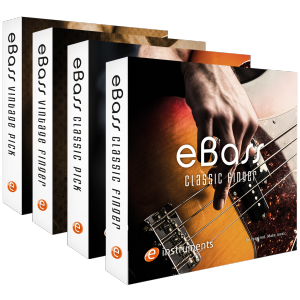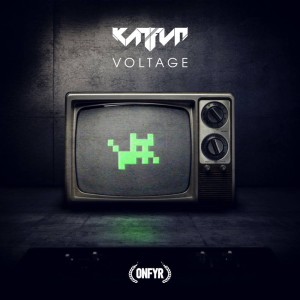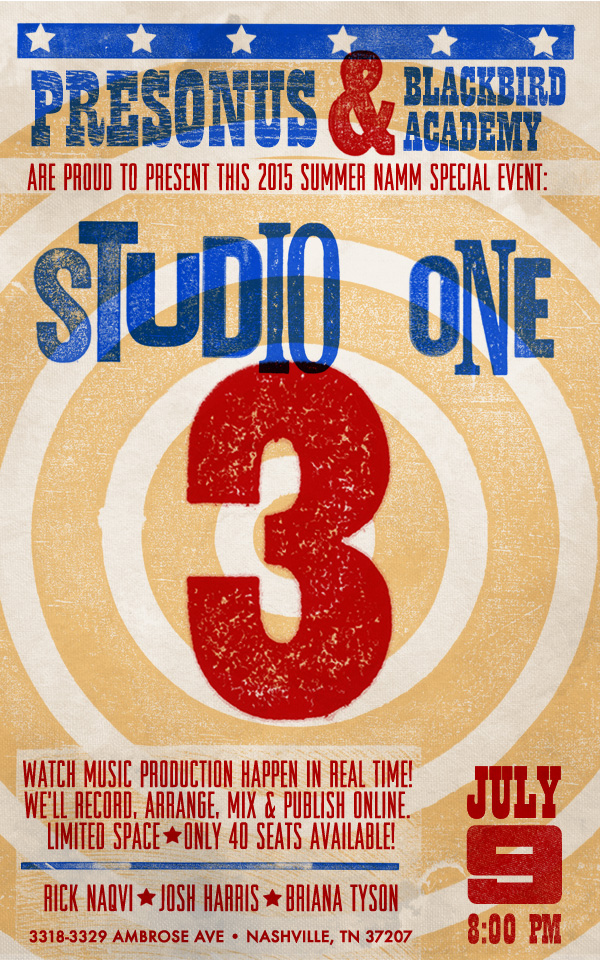Tag Archives: Studio One 3
Pete “Boxsta” Martin with Boxsta Music on Studio One 3.2
Pete “Boxsta” Martin with Boxsta Music is an award winning, multi-talented producer/songwriter and one of the most sought after mix engineer in the world. He has worked with a variety of top selling artists such as Arrow Benjamin, Jessie J, Sugababes, Alexandra Burke, and Missy Elliot. Here he discusses leaving Pro Tools for Studio One 3.2 and the ease of the transition.
“Studio One is an incredible platform because it’s the best of every DAW out there. It’s totally new and fresh; it encompasses everything you need.” – Pete Martin.
For more on Studio One 3.2, click HERE.
Try Studio One Professional Demo for FREE for 30 days!
Introducing the eBass Add-ons for Studio One 3
 [This just in from Thomas Koritke of e-instruments, who shared some valuable insights on the creation of our new eBass Add-ons for Studio One 3! These sample packs include VERY meticulously sampled recordings of a 1975 P-Bass in various styles. They’re available for all editions of Studio One 3: Artist, Professional, and Prime, and can be purchased on shop.presonus.com website or directly from inside Studio One.]
[This just in from Thomas Koritke of e-instruments, who shared some valuable insights on the creation of our new eBass Add-ons for Studio One 3! These sample packs include VERY meticulously sampled recordings of a 1975 P-Bass in various styles. They’re available for all editions of Studio One 3: Artist, Professional, and Prime, and can be purchased on shop.presonus.com website or directly from inside Studio One.]
We are really happy to see our eBass released! I hope the following gives you some valuable information on our instruments.
We recorded a 1975 Precision Bass in a studio here in Hamburg—actually the same studio that we used to record our Session Strings, Session Horns and Session Keys instruments. It is one of the few facilities left with a large and great sounding room.
We used a Millenia TD-1 tube channel for the Vintage Bass instruments, and an Avalon DI preamp for the Classic Bass. We also recorded the bass via an Ampeg SVT top with 112 speaker, just as a sound reference. However, we ended up using only the DI signals for our eBass instruments. The DI signal provides great flexibility for additional processing with amp simulators and EQ, so the reference amp recording was a tremendous help when we designed the Instrument+FX presets—we could always compare them to the real thing. Strings were medium 045-105 round-wound for the classic and the same gauge flat-wound strings for the vintage. The pickup set was the original from 1975.
The bass was performed by a completely unknown, but extremely patient bassist here from Hamburg. Sampling requires a very special skill set and what we ask a musician can be quite hard or boring for a famous virtuoso. The player has to be able to have great control over dynamics and sound as well as keeping a certain dynamic throughout the entire tonal range. He has to be very patient and controlled, should not produce any noise, should not move, and has to repeat notes several hundred times… it’s a painful process, but it’s worth it: with both flatwound and roundwound strings and two playing styles—pick and finger—for each string type, eBass provides THE classic Precision Bass sounds.
Despite the previously mentioned attention to details, I think the most interesting part of the product is in its scripting, sound design, and music loops. Our goal is to provide very flexible and easy to use great sounding bass sounds. As such, we designed these Add-ons with presets for different use cases. Some people love to perform a bass line on a keyboard. The performance presets are designed specifically for that. They include an intuitive legato function (legato on the same string–within a fourth interval), velocity switching for dead notes or harmonics, pitch bend control to trigger slides and hammer-on/pull-offs and even control over the left hand position on the neck via mod wheel. All articulations are instantly available.
Other producers are used to selecting different articulations via key switches. We have created the production presets for them. Here, all articulations are accessible via dedicated keyswitches. The production presets also feature left hand position control via mod wheel. Both preset types are available as “dry” Presence XT presets, or as Instrument+FX presets including a chain of Ampire, EQ and Compressor.
Finally, some musicians may just need some inspiration or use an existing bass line and modify it. Each eBass includes Musicloops in different styles, genres and complexity levels – from fairly basic to quite busy. They all come with a dedicated effects chain setting to match that specific style or genre.
All the best,
Thomas Koritke
e-instruments
Studio One 3 Launch: Los Angeles Studio Chat—Part 2 of 3
Studio One 3 Launched on May 20, 2015. Marketing Director Carl Jacobson sat down at Burbank, California’s Legend Studio with a panel of engineer, DJs, and producers including Sak Pase, AG, KATFYR, Chaka Blackmon, and DJ Faust to talk about why they’ve chosen Studio One over other DAWs.
Learn more about Studio One 3 and try the demo here: http://studioone.presonus.com/
Studio One 3 Launch: Los Angeles Studio Chat—Part 1 of 3
Studio One 3 Launched on May 20, 2015. Marketing Director Carl Jacobson sat down at Burbank, California’s Legend Studio with a panel of engineers, DJs, and producers including Sak Pase, AG, KATFYR, Chaka Blackmon, and DJ Faust to talk about why they’ve chosen Studio One over other DAWs.
Learn more about Studio One 3 and try the demo here: http://studioone.presonus.com/
.@KATFYR’s Latest Release, “Voltage,” Produced in Studio One, Available now on BeatPort
[This just in from KATFYR, who just released “Voltage“—produced entirely in Studio One! You can (and should) buy Voltage on BeatPort by clicking here. You can also listen to the track below, and check out the video interview to learn a few more details about his production tricks.]
My latest release, Voltage, was produced with Studio One 3 from start to finish. I got to take advantage of many of its newest features.
The new Arranger Track expedited the process of building the entire song structure. It enabled me to easily duplicate whole sections of the arrangement and move them around. The Scratch Pad enabled me to test how different sections interact with each other in order to find the best flow for the track.
I’ve also made good use of the new Effect Splitter feature, particularly in the bus channels for bass and synth sounds, where I was able to pinpoint certain frequencies and apply effects directly to those areas. It would nearly impossible to get the sounds I did using anything else!

Studio One 3 Developer Interview—Part 3 of 3: Control
Russ Hughes of Studio One Expert and Pro Tools Expert hangs out with Arnd Kaiser and Matthias Juwan of PreSonus software in Hamburg during the launch of Studio One 3. This time around, they discuss some of the updates and new features related to controlling Studio One.
Learn more about Studio One 3 and try the demo here: http://studioone.presonus.com/
Check out Studio One Expert here: http://www.studio-one.expert/
Live at Summer NAMM: PreSonus and Blackbird Academy Present Studio One 3—July 9
Join us at Summer NAMM for a live tracking session with Briana Tyson and friends! Anyone interested in modern recording techniques and digital recording won’t want to miss this.
Rick Naqvi and Josh Harris will record Briana and her band using the Studio 192 and Studio One 3. Get a look at working with the latest version of Studio One in the real world! We’ll record, arrange, mix & publish online.
The event is FREE to get in but we only have 40 spots available… sign up now!
Thursday, July 9, 8:00 p.m.
Blackbird Academy
3318-3320 Ambrose Ave
Nashville, TN 37207
Studio One 3 Developer Interview—Part 2 of 3: Sound Design
Russ Hughes of Studio One Expert and Pro Tools Expert hangs out with Arnd Kaiser and Matthias Juwan of PreSonus software in Hamburg during the launch of Studio One 3. In this video, they take a look at Studio One 3 from a sound design perspective.
Learn more about Studio One 3 and try the demo here: http://studioone.presonus.com/
Check out Studio One Expert here: http://www.studio-one.expert/
Tacio Makes the Switch from Sonar to #StudioOne3, Releases Performance Video | @tacioofficial
[This just in from recent Studio One 3 convert, Tacio!]
Hey Guys, Wassup? I’m Tacio (music producer/songwriter/director/artist) and I’m here to talk about this amazing DAW, the new Studio One 3 by PreSonus. I was talking with a friend from New York and she told me about the software, so I decided to test it and the result was great!
The new Studio One has powerful tools, a multi-touch interface, great plugins, synths, a great browser and much more. Moving from Sonar to Studio One 3 was a quick and easy task, in a few hours all of my songs—and the songs of my clients—were running in Studio One. To me it seems to incorporate the best features of all the other DAWs I’ve ever used, but is incredibly quick and intuitive to use.
This program took my productions to the next level, I’m a fan.
To see more of my work and connect with me, please use the following links.
- www.facebook.com/taciomusic
- www.reverbnation.com/tacio
- Twitter: @tacioofficial
- Instagram: @taciomusic
Ilias Gogakis on Studio One
[This just in from Ilias Gogakis, rock and metal producer/mix and mastering engineer at Master Sound Studio and longtime PreSonus user. He recently created some Studio One 3 videos in Greek—the playlist is linked below!]
My name is Ilias Gogakis, and I have worked as a mix and mastering engineer for the past five years. I am currently based in High Wycombe, Buckinghamshire, in the United Kingdom. I am coming from a ten year career in IT, as a network engineer, but I decided to change careers and follow my big passion: music. I have also studied electric guitar and I have the RGT certificate from London College of Music. I was very lucky so far to have two very talented music tutors by my side, Kyriakos Kouvelas and Theodore Ziras. They both helped me to achieve my personal goals, open new horizons and overcome my limits as a guitarist. Today I am enrolled in a the Bucks New University, based in High Wycombe, in a module for Sound Design for Film and TV, as I want to expand my knowledge regarding sound design, surround effects and digital audio technology.
I remember myself as a hardcore Cubase user. But always looking for something better, as I had a feeling that something was missing from the software. My first contact with PreSonus Studio One was back in summer 2011, when I was searching the internet for demos and reviews about modern DAWs. I remember myself reading reviews from SoundOnSound magazine, Gearslutz.com, and all the major webzines, along with videos on YouTube.
I was very interested in testing it as, at that time, I was looking to change my DAW to something more modern. I have to admit that 2011 was the “DAW testing” year for me. I was downloading demos from every company’s website and testing them in order to try them out and look if there is that little something that would make me say “Yes, this is it. Now let’s start make some music—easy, fast, reliable.” I must say that after my friend told me to take a better look at Studio One, there was no turning back.
I remember I downloaded the demo for version 2 back in the day, installed in, and that was the beginning. Since I was a Cubase user, the key commands where similar, and the workflow was about 40% faster. I have to admit that I opened the manual only three times, just to change some options and see some new features, and fine-tune some advanced setting regarding my interface. Since that day, I use Studio One every day in my mixes. One of the great features that I really like is the integrated Project Page for mastering. It is a very helpful project page that helps me go back and forth in the mix and make instant changes to my master files. In my mixes I use OpenAir reverb and the Analog Delay on every song, and all the modulation effects such us chorus, flanger and the Redlight Distortion often find their place in my mixes. Also, the stock PreSonus ProEQ is a very good parametric EQ to make tonality changes to any instrument during my mixing sessions, and can be very helpful for mastering. Some other tools that I use every day in my mixes are the Slate Digital and Eiosis tools. These analog emulation tools they just sound amazing, and they work flawlessly with Studio One.
In conclusion, PreSonus Studio One in version 2 was an amazing production system—and version 3 is more mature, with many improvements. It’s more stable, more virtual instruments, and more new functions, which really helps you in your daily workflow, no matter how you use the software, recording, mixing or mastering.
Find out more about my work at the following links:
Greek Studio One videos:


